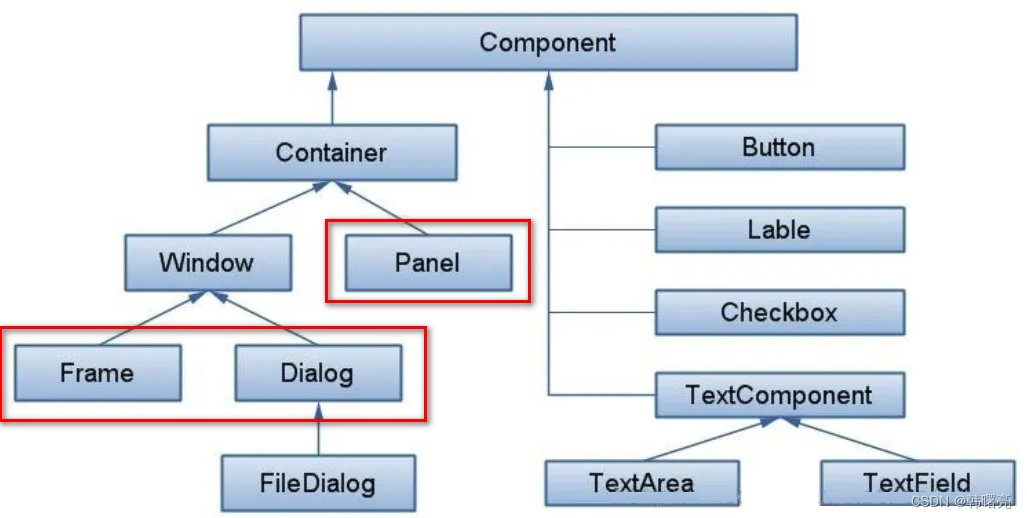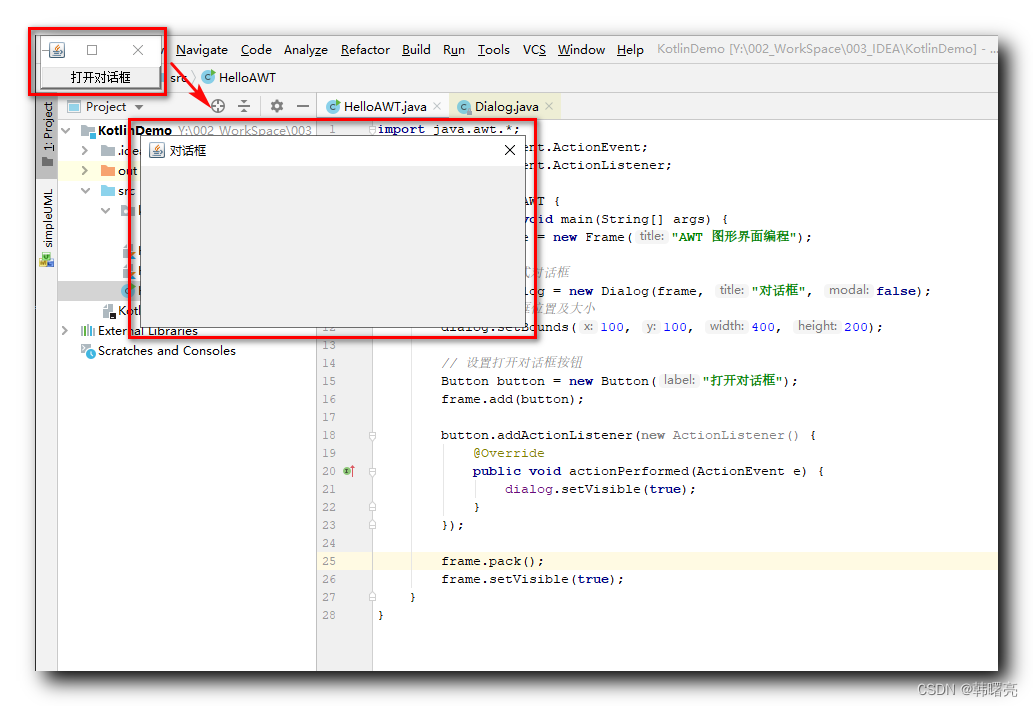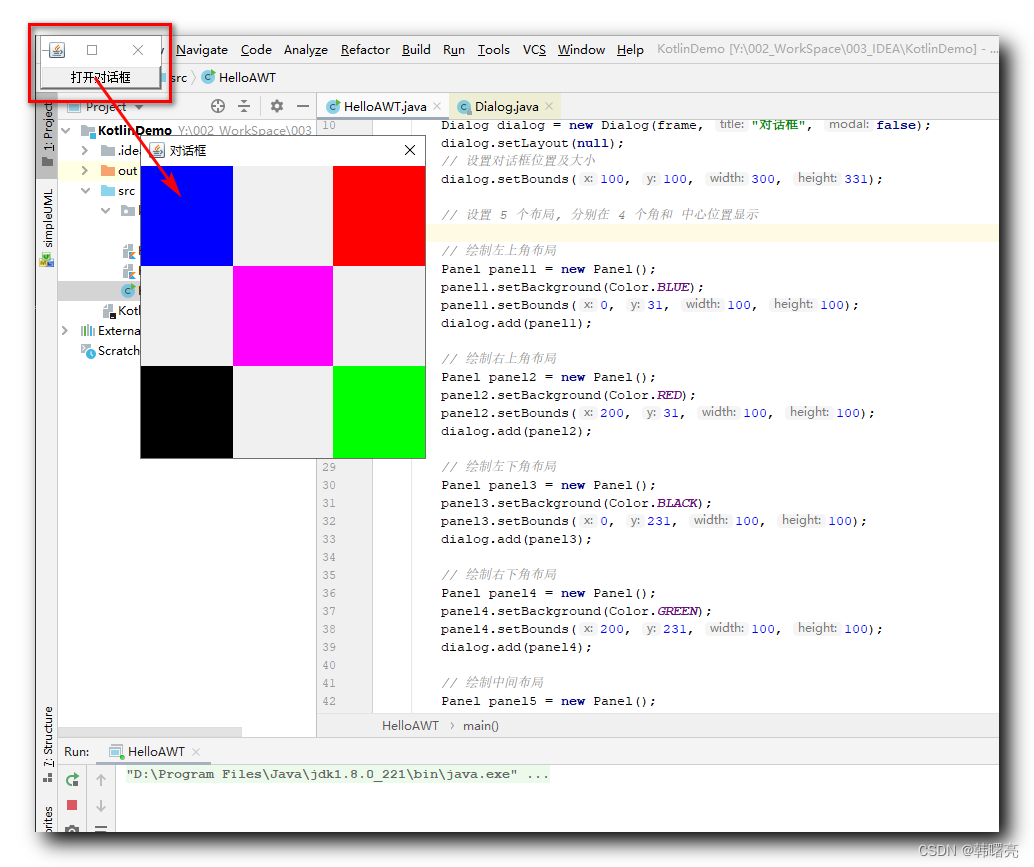【Java AWT 图形界面编程】Dialog 对话框 ( 简介 | 模式对话框 | 非模式对话框 | Dialog 构造函数 | Dialog 代码示例 | 向 Dialog 对话框添加布局组件 )
文章目录
- 一、Dialog 对话框简介
- 二、Dialog 构造函数
- 三、Dialog 对话框代码示例
- 四、向 Dialog 对话框添加布局组件
一、Dialog 对话框简介
Dialog 对话框 是 Window 的子类 , 在 AWT 图形界面编程 中 , 最常见的 三种 Container 容器就是 Frame , Dialog , Panel ;
Dialog 对话框 需要 依赖一个 Frame 窗口 , 该 Frame 窗口就是该对话框的父窗口 , 一旦关闭父窗口 , 则其附属的 Dialog 对话框也会一同关闭 ;
Dialog 对话框有两种模式 :
- 非模式 : 对话框 与 窗口 是 相对独立的 , 互不影响 ;
- 模式 : 对话框总是位于 父窗口 上面 , 对话框没有关闭时 , 父窗口无法操作 ;
Dialog 与 Window 的关系如下图 , Window 类有 2 个子类 , Frame 窗口类 和 Dialog 对话框类 ;

二、Dialog 构造函数
Dialog 构造函数 原型 :
- Frame owner 参数 : 是 Dialog 对话框 依赖的父窗口 , 也就是在该窗口中创建的 Dialog 对话框 ;
- String title 参数 : Dialog 对话框的 标题 ;
- boolean modal 参数 : 设置对话框是 模式 还是非模式 , true 为模式 抢占父窗口焦点 , false 为非模式 与 父窗口独立操作 ;
public Dialog(Frame owner, String title, boolean modal) {this(owner, title, modal ? DEFAULT_MODALITY_TYPE : Dialog.ModalityType.MODELESS);}
Dialog 构造函数 原型 文档 :
/*** Constructs an initially invisible Dialog with the* specified owner Frame, title and modality.** @param owner the owner of the dialog or null if* this dialog has no owner* @param title the title of the dialog or null if this dialog* has no title* @param modal specifies whether dialog blocks user input to other top-level* windows when shown. If false, the dialog is MODELESS;* if true, the modality type property is set to* DEFAULT_MODALITY_TYPE* @exception java.lang.IllegalArgumentException if the owner's* GraphicsConfiguration is not from a screen device* @exception HeadlessException when* GraphicsEnvironment.isHeadless() returns true** 构造一个初始不可见的对话框与指定的所有者框架,标题和模式。* @param owner对话框的所有者,如果这个对话框没有所有者,则为空* @param title对话框的标题,如果对话框没有标题,则为空* @param modal指定对话框显示时是否阻止用户输入到其他顶级窗口。如果为false,则对话框为MODELESS;* 如果为真,则modality类型属性设置为DEFAULT_MODALITY_TYPE* @exception java.lang.IllegalArgumentException如果所有者* GraphicsConfiguration不是来自屏幕设备* 当GraphicsEnvironment.isHeadless()返回true时,@exception HeadlessException异常** @see java.awt.Dialog.ModalityType* @see java.awt.Dialog.ModalityType#MODELESS* @see java.awt.Dialog#DEFAULT_MODALITY_TYPE* @see java.awt.Dialog#setModal* @see java.awt.Dialog#setModalityType* @see java.awt.GraphicsEnvironment#isHeadless* @see Component#setSize* @see Component#setVisible*/public Dialog(Frame owner, String title, boolean modal) {this(owner, title, modal ? DEFAULT_MODALITY_TYPE : Dialog.ModalityType.MODELESS);}
三、Dialog 对话框代码示例
要想显示 Dialog 对话框 , 执行下面 3 个步骤操作即可 :
- 首先 , 创建 Dialog 对话框 ;
- 然后 , 设置 Dialog 对话框 位置 和 大小 ;
- 最后 , 设置 Dialog 对话框 可见 ;
// 1. 创建非模式对话框Dialog dialog = new Dialog(frame, "对话框", false);// 2. 设置对话框位置及大小dialog.setBounds(100, 100, 400, 200);// 3. 设置对话框可见 dialog.setVisible(true);
代码示例 :
import java.awt.*;
import java.awt.event.ActionEvent;
import java.awt.event.ActionListener;public class HelloAWT {public static void main(String[] args) {Frame frame = new Frame("AWT 图形界面编程");// 创建非模式对话框Dialog dialog = new Dialog(frame, "对话框", false);// 设置对话框位置及大小dialog.setBounds(100, 100, 400, 200);// 设置打开对话框按钮Button button = new Button("打开对话框");frame.add(button);button.addActionListener(new ActionListener() {@Overridepublic void actionPerformed(ActionEvent e) {dialog.setVisible(true);}});frame.pack();frame.setVisible(true);}
}
执行结果 :

四、向 Dialog 对话框添加布局组件
将 【Java AWT 图形界面编程】Frame 窗口标题栏大小问题 ( Container 容器的空白边框 Insets | 通过调用 frame.getInsets().top 获取窗口标题栏高度 ) 博客中的布局组件放到对话框中 ;
在第一章已经提到 Dialog 是 Window 的子类 , Dialog 也是 Container 容器的一种 , 可以设置布局管理器 , 可以向其中添加子组件 ;
代码示例 :
import java.awt.*;
import java.awt.event.ActionEvent;
import java.awt.event.ActionListener;public class HelloAWT {public static void main(String[] args) {Frame frame = new Frame("AWT 图形界面编程");// 创建非模式对话框Dialog dialog = new Dialog(frame, "对话框", false);dialog.setLayout(null);// 设置对话框位置及大小dialog.setBounds(100, 100, 300, 331);// 设置 5 个布局, 分别在 4 个角和 中心位置显示// 绘制左上角布局Panel panel1 = new Panel();panel1.setBackground(Color.BLUE);panel1.setBounds(0, 31, 100, 100);dialog.add(panel1);// 绘制右上角布局Panel panel2 = new Panel();panel2.setBackground(Color.RED);panel2.setBounds(200, 31, 100, 100);dialog.add(panel2);// 绘制左下角布局Panel panel3 = new Panel();panel3.setBackground(Color.BLACK);panel3.setBounds(0, 231, 100, 100);dialog.add(panel3);// 绘制右下角布局Panel panel4 = new Panel();panel4.setBackground(Color.GREEN);panel4.setBounds(200, 231, 100, 100);dialog.add(panel4);// 绘制中间布局Panel panel5 = new Panel();panel5.setBackground(Color.MAGENTA);panel5.setBounds(100, 131, 100, 100);dialog.add(panel5);// 设置打开对话框按钮Button button = new Button("打开对话框");frame.add(button);button.addActionListener(new ActionListener() {@Overridepublic void actionPerformed(ActionEvent e) {dialog.setVisible(true);}});frame.pack();frame.setVisible(true);}
}
执行结果 :

本文来自互联网用户投稿,文章观点仅代表作者本人,不代表本站立场,不承担相关法律责任。如若转载,请注明出处。 如若内容造成侵权/违法违规/事实不符,请点击【内容举报】进行投诉反馈!